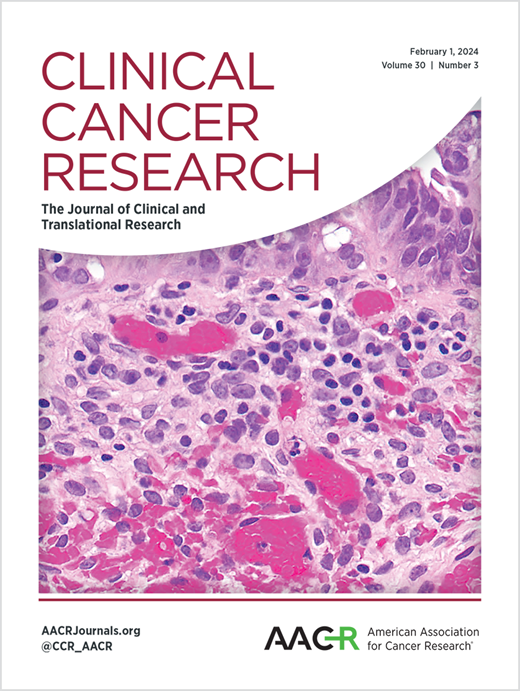A population-level real-world analysis and single-center validation of melanoma brain metastasis epidemiology following dual-agent immunotherapy
IF 10.2
1区 医学
Q1 ONCOLOGY
引用次数: 0
Abstract
Purpose: Melanoma brain metastases (MBM) are common in advanced melanoma and linked to poor prognosis. Preventing MBM can improve survival and reduce morbidity. While dual-agent immunotherapy (dIT) improves survival, its role in MBM prevention is unclear. We compared MBM incidence, overall survival (OS), and brain metastasis-free survival (BMFS) between dIT and single-agent immunotherapies (sIT). Experimental Design: A real-world multi-institutional database identified melanoma patients without MBM at immunotherapy (IT) initiation. Patients were stratified by anti-CTLA4, anti-PD1, and combo anti-CTLA4/anti-PD1 (dIT) treatment. MBM incidences were measured within 5 years post-IT initiation and compared with risk ratios (RR). In a complementary single-institution cohort, median OS and BMFS were compared between dIT, anti-CTLA4, and anti-PD1 via log-rank tests and multivariate Cox proportional-hazards models. Results: TriNetX identified 8,287 patients receiving anti-CTLA (3,205), anti-PD1 (3,218), and dIT (1,864). MBM incidence was significantly lower in dIT (8.6%) and anti-PD1 (7.8%) vs. anti-CTLA4 (12.2%) cohorts, (RR[95% CI], 0.72[0.61-0.86] and 0.63[0.57-0.70], respectively). There was no significant difference in MBM incidence between anti-PD1 (7.8%) and dIT (8.6%) (RR[95% CI], 1.13[0.93-1.36]). In the single-institution analysis (n=119), 2-year OS probabilities were 90%, 80%, and 95%, and 2-year BMFS probabilities were 72.7%, 80%, and 95.7%, in the dIT, anti-CTLA4, and anti-PD1 cohorts, respectively. DIT and anti-PD1 showed improved early-phase protection against MBM development. Number of metastatic sites was significantly associated with MBM development (HR 2.36; 95% CI [1.22-4.58]; p=0.01). Conclusions: These findings highlight dIT’s potential role in primary prophylaxis against MBM, with anti-PD1 as the likely work horse agent. Prospective studies are warranted.双药免疫治疗后黑色素瘤脑转移流行病学的人群水平分析和单中心验证
目的:黑色素瘤脑转移(MBM)在晚期黑色素瘤中很常见,与预后不良有关。预防骨髓瘤可提高生存率,降低发病率。虽然双药免疫治疗(dIT)可以提高生存率,但其在MBM预防中的作用尚不清楚。我们比较了dIT和单药免疫治疗(sIT)之间的MBM发病率、总生存期(OS)和无脑转移生存期(BMFS)。实验设计:一个真实世界的多机构数据库确定了在免疫治疗(IT)开始时没有MBM的黑色素瘤患者。患者采用抗ctla4、抗pd1和抗ctla4 /抗pd1 (dIT)联合治疗进行分层。在it开始后的5年内测量MBM发病率,并比较风险比(RR)。在一个互补的单机构队列中,通过对数秩检验和多变量Cox比例风险模型比较dIT、抗ctla4和抗pd1的中位OS和BMFS。结果:TriNetX鉴定了8287例接受抗ctla(3205例)、抗pd1(3218例)和dIT(1864例)治疗的患者。与抗ctla4组(12.2%)相比,dIT组(8.6%)和抗pd1组(7.8%)的MBM发病率显著降低(RR[95% CI],分别为0.72[0.61-0.86]和0.63[0.57-0.70])。抗pd1组MBM发生率(7.8%)与dIT组(8.6%)无显著性差异(RR[95% CI], 1.13[0.93-1.36])。在单机构分析(n=119)中,在dIT、抗ctla4和抗pd1队列中,2年OS概率分别为90%、80%和95%,2年BMFS概率分别为72.7%、80%和95.7%。DIT和抗pd1对MBM的早期保护作用增强。转移部位的数量与MBM的发展显著相关(HR 2.36;95% ci [1.22-4.58];p = 0.01)。结论:这些发现强调了dIT在MBM一级预防中的潜在作用,抗pd1可能是主要的药物。前瞻性研究是必要的。
本文章由计算机程序翻译,如有差异,请以英文原文为准。
求助全文
约1分钟内获得全文
求助全文
来源期刊

Clinical Cancer Research
医学-肿瘤学
CiteScore
20.10
自引率
1.70%
发文量
1207
审稿时长
2.1 months
期刊介绍:
Clinical Cancer Research is a journal focusing on groundbreaking research in cancer, specifically in the areas where the laboratory and the clinic intersect. Our primary interest lies in clinical trials that investigate novel treatments, accompanied by research on pharmacology, molecular alterations, and biomarkers that can predict response or resistance to these treatments. Furthermore, we prioritize laboratory and animal studies that explore new drugs and targeted agents with the potential to advance to clinical trials. We also encourage research on targetable mechanisms of cancer development, progression, and metastasis.
 求助内容:
求助内容: 应助结果提醒方式:
应助结果提醒方式:


